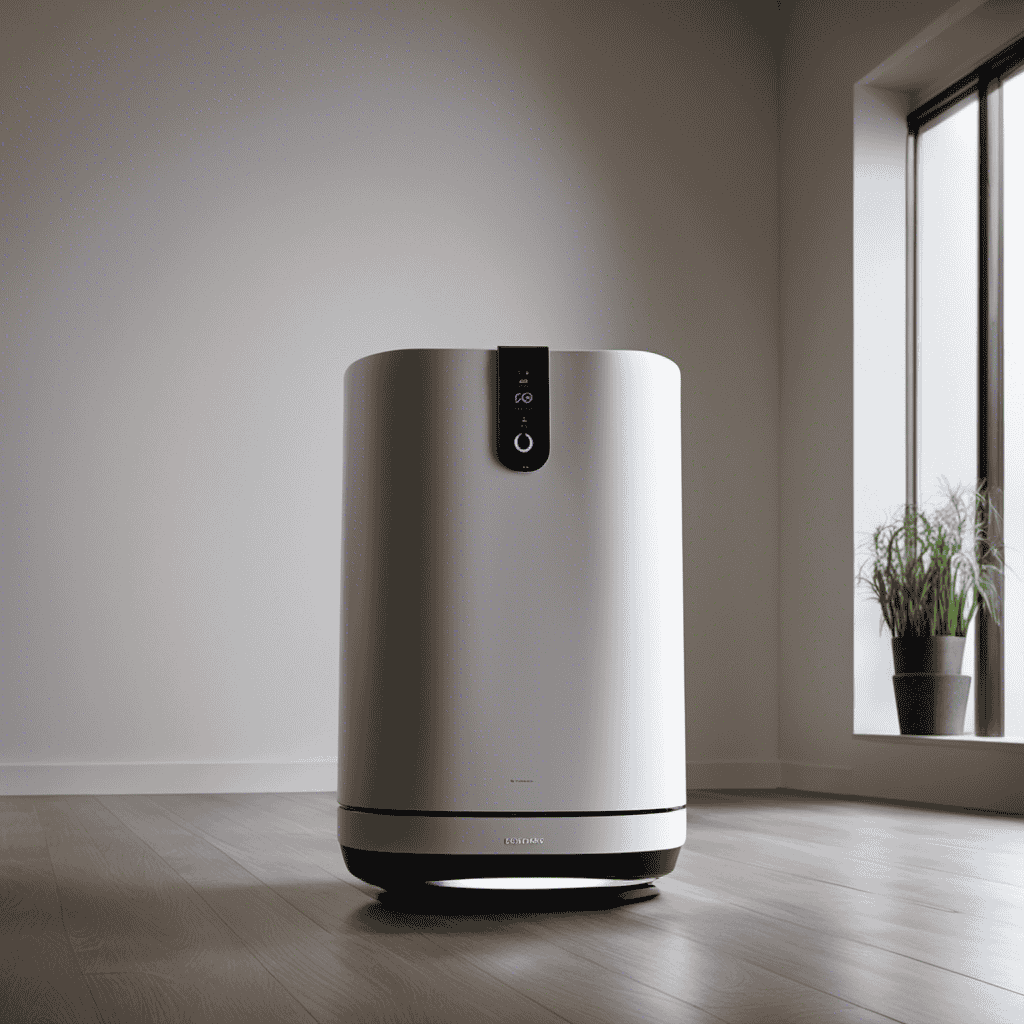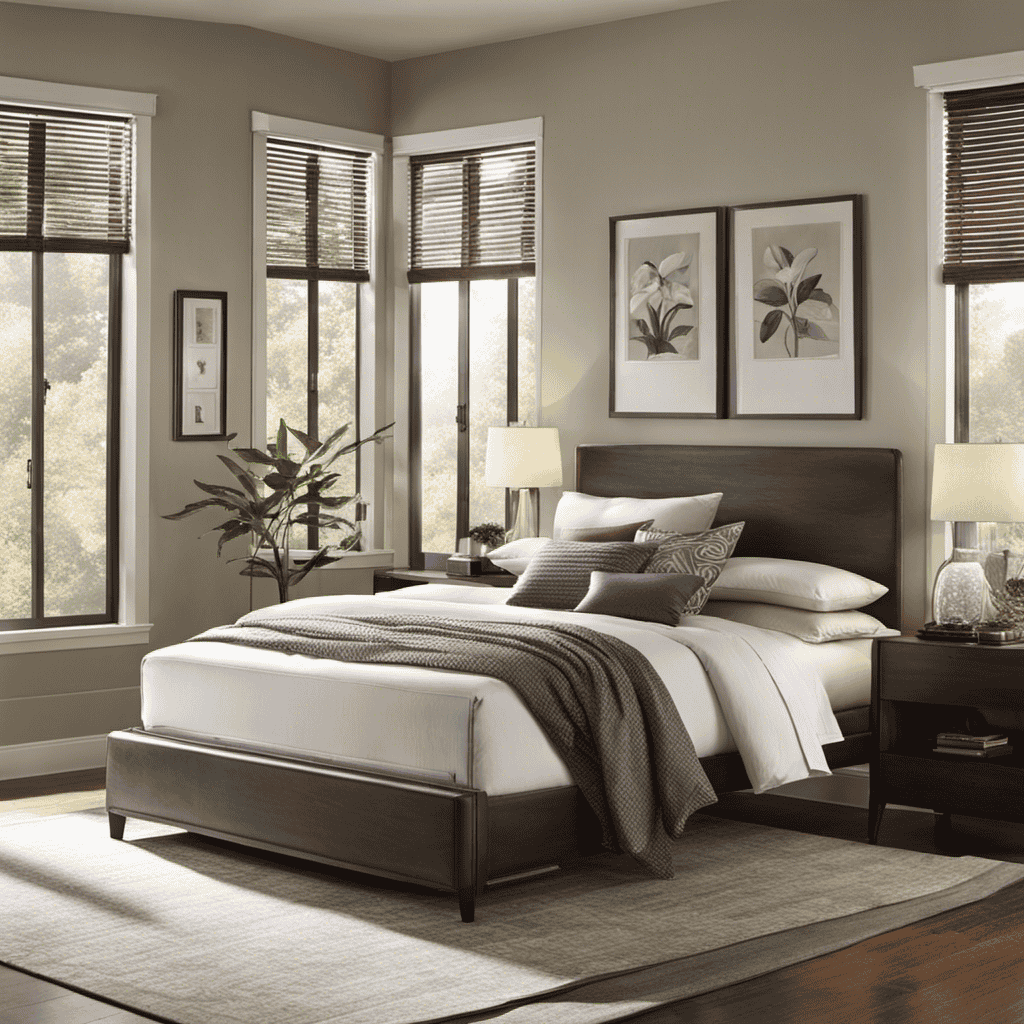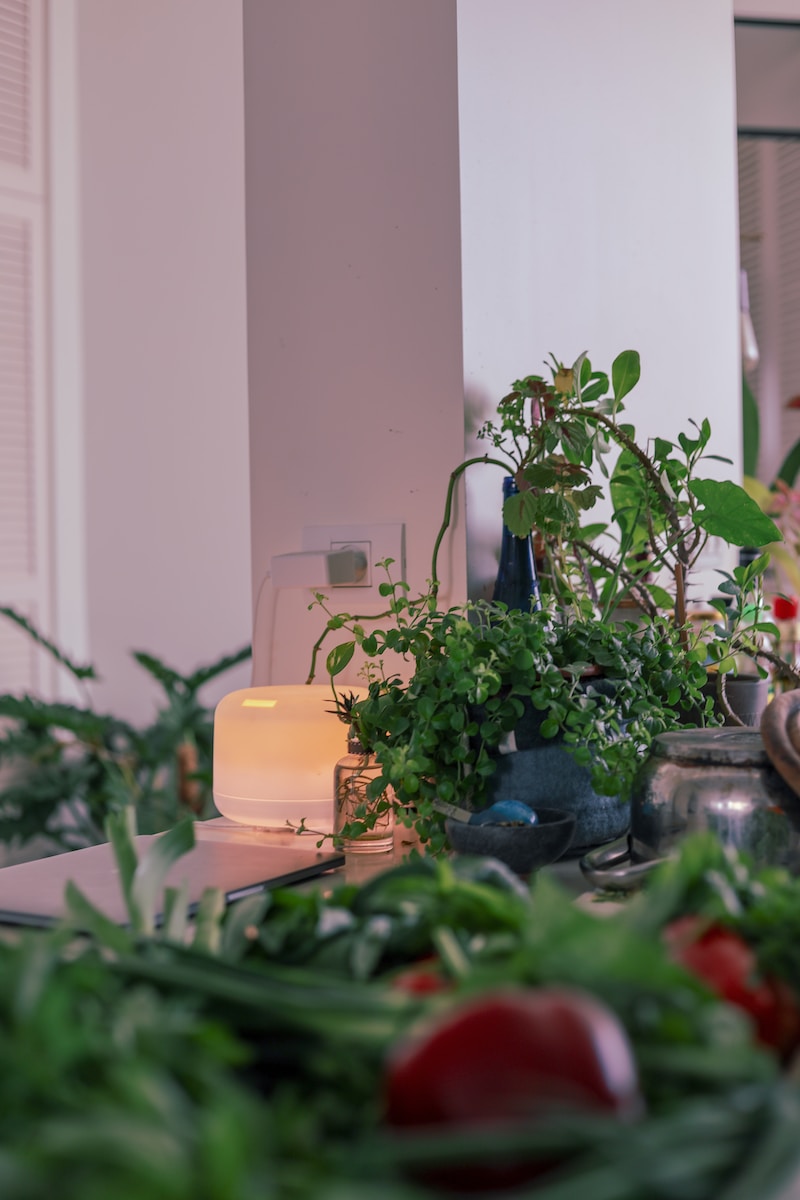Have you ever been peacefully sleeping, only to be abruptly awoken by a strange, unexplained noise? That’s exactly how I felt when my air purifier started making a loud noise.
It was supposed to provide me with clean, quiet air, but instead, it sounded like a freight train in my room.
If you’re experiencing the same frustration, fear not! In this article, I will delve into the common causes of air purifier noise and provide you with practical solutions to bring tranquility back to your home.
Key Takeaways
- Dirty or clogged filters can obstruct airflow and cause noise in an air purifier.
- Choosing a quiet air purifier with noise reduction technology is important for a peaceful environment.
- Loose parts, bent fan blades, and malfunctioning motors can also contribute to air purifier noise.
- Techniques such as proper placement, soundproofing materials, and vibration isolation can help reduce air purifier noise.
Common Causes of Air Purifier Noise
One common cause of your air purifier making noise is a dirty or clogged filter. When the filter becomes dirty or clogged with dust, pet hair, or other particles, it can obstruct the airflow and cause the fan to work harder, resulting in increased noise.
To prevent this, it is important to regularly clean or replace the filter according to the manufacturer’s instructions.
Another factor that can contribute to air purifier noise is the quality of the purifier itself. Some air purifiers are designed to be silent, employing advanced noise reduction technologies to minimize sound output. When purchasing an air purifier, look for models labeled as ‘silent’ or ‘ultra-quiet’ to ensure a quieter operation.
Noise measurement techniques, such as decibel meters, can be used to determine the noise level of an air purifier and compare it to recommended noise standards for optimal comfort.
Understanding the Different Types of Air Purifier Noise
When it comes to air purifiers, noise can be a common annoyance. In this discussion, I will be covering three key points related to air purifier noise:
- The causes and solutions for noise.
- Tips for choosing a quiet purifier.
- Techniques for reducing noise.
By understanding these aspects, you will be able to make an informed decision and create a more peaceful environment in your home or office.
Noise Causes and Solutions
There are a few common reasons why your air purifier might be making noise, and there are also some simple solutions you can try. Here are four possible causes of air purifier noise and how to address them:
-
Loose parts: Check if any screws or components are loose and tighten them. This could help reduce vibrations and rattling noises.
-
Clogged filters: Dirty filters can obstruct airflow, causing the motor to work harder and create noise. Clean or replace the filters regularly to maintain optimal performance.
-
Fan blade issues: If the fan blades are bent or damaged, they can create a whirring or scraping sound. Inspect the blades and straighten or replace them if necessary.
-
Motor problems: A malfunctioning motor can produce loud grinding or humming noises. If this is the case, it may require professional repair or replacement.
Choosing a Quiet Purifier
To choose a quiet purifier, you should consider the decibel levels and look for models specifically designed for noise reduction. A silent operation is essential for those who want a peaceful environment while enjoying the benefits of cleaner air. Noise level comparison is crucial in finding the right air purifier for your needs. Here is a table comparing the decibel levels of different purifier models:
| Model | Low Speed (dB) | Medium Speed (dB) | High Speed (dB) |
|---|---|---|---|
| A | 35 | 45 | 55 |
| B | 40 | 50 | 60 |
| C | 30 | 40 | 50 |
| D | 25 | 35 | 45 |
Noise Reduction Techniques
Consider using noise reduction techniques to create a quieter environment while using your air purifier. Here are some soundproofing methods and noise canceling technology options to help minimize the noise:
- Placement: Position your air purifier away from walls and corners to reduce sound reflections.
- Soundproofing materials: Use acoustic foam or soundproof curtains to absorb and block noise.
- Vibration isolation: Place your air purifier on a rubber mat or anti-vibration pads to reduce vibrations and noise transmission.
- Noise canceling technology: Invest in air purifiers with built-in noise canceling features, such as active noise control or sound-dampening technology.
How to Identify and Fix Noisy Air Purifier Components
When it comes to troubleshooting and repairing a noisy air purifier, there are a few key points to consider.
Firstly, identifying the source of the noise is crucial in order to effectively fix the problem. This may involve examining components such as the fan, motor, or filters to determine if they need cleaning, lubrication, or replacement.
Troubleshooting Noisy Air Purifier
If your air purifier is making noise, try adjusting the fan speed to see if that resolves the issue. Here are some troubleshooting techniques to reduce noise in your air purifier:
-
Clean the filters: Accumulated dirt and debris can cause the fan to work harder, resulting in noise. Regularly clean or replace the filters to ensure smooth airflow.
-
Check for loose parts: Inspect the air purifier for any loose screws, panels, or components. Tighten or secure them properly to eliminate rattling or vibrating sounds.
-
Positioning matters: Place the air purifier on a stable, level surface to prevent vibrations that can lead to noise. Keep it away from walls, furniture, or other objects that may obstruct airflow.
-
Regular maintenance: Perform routine maintenance, such as lubricating the fan motor or cleaning the fan blades, to ensure optimal performance and reduce noise.
Repairing Noisy Air Purifier
To repair a noisy air purifier, try tightening any loose screws or panels and placing it on a stable surface to prevent vibrations. If the noise persists, it may be necessary to inspect and repair the filters. Start by checking for any clogs or debris that may be obstructing the airflow. Clean or replace the filters as needed. Additionally, make sure the fan blades are clean and free from dust build-up, as this can cause noisy operation. If the noise continues after these steps, it may indicate a problem with the motor or other internal components, which may require professional repair or replacement. Remember, regular maintenance and cleaning of your air purifier can help prevent issues and extend its lifespan.
| Common Air Purifier Issues | Possible Solutions |
|---|---|
| Loud noise | Tighten screws and panels |
| Place on stable surface | |
| Clogged filters | Clean or replace filters |
| Dusty fan blades | Clean blades to remove dust |
Tips for Reducing Air Purifier Noise in Your Home
One way to reduce air purifier noise in your home is by placing it on a stable surface.
Here are some additional tips to help minimize the noise:
-
Soundproofing solutions: Consider using soundproofing materials such as foam or acoustic panels to absorb and block the noise generated by the air purifier.
-
Noise canceling technology: Look for air purifiers equipped with noise-canceling technology. These models use advanced algorithms to analyze and reduce the noise produced by the purifier.
-
Distance and positioning: Place the air purifier away from walls or furniture to prevent sound vibrations from being amplified. Also, try positioning it in a corner or against a wall to further reduce noise transmission.
-
Regular maintenance: Keep your air purifier clean and well-maintained. Dust and debris can cause the unit to work harder and produce more noise.
When to Seek Professional Help for a Noisy Air Purifier
When your air purifier is making excessive noise and you’ve tried all the troubleshooting steps, it may be time to seek professional help.
While some noise is normal, loud or unusual noises can be signs of a malfunctioning air purifier.
Before calling in a professional, it’s important to ensure that you’ve cleaned the filters and checked for any loose parts.
If the noise persists, it could be an indication of a more serious issue, such as a faulty motor or fan.
In such cases, it’s best to consult a professional rather than attempting a DIY fix, as they have the expertise and tools to accurately diagnose and repair the problem.
Maintenance and Cleaning Techniques to Prevent Air Purifier Noise
Ensure you regularly clean and maintain your air purifier to prevent any potential noise issues. Here are four important maintenance and cleaning techniques to keep your air purifier running smoothly:
-
Clean the filters: Dirty filters can cause the motor to work harder, leading to increased noise. Remove and clean the filters according to the manufacturer’s instructions. Regularly replacing filters is also crucial for optimal performance.
-
Dust the exterior: Dust can accumulate on the exterior of the air purifier, affecting its overall efficiency. Use a soft cloth or brush to gently remove any dust or debris from the surface.
-
Check the fan blades: Over time, dirt and debris can build up on the fan blades, causing them to become unbalanced and produce noise. Carefully clean the fan blades using a soft brush or cloth.
-
Inspect the motor: The motor is the heart of your air purifier. Check for any signs of wear or damage, such as loose screws or broken parts. If you notice any issues, contact a professional for repair or replacement.
Frequently Asked Questions
How Much Noise Is Considered Normal for an Air Purifier?
When it comes to air purifiers, acceptable noise levels can vary. However, a general rule of thumb is that noise levels below 50 decibels are considered normal. To reduce air purifier noise, try cleaning or replacing the filters regularly.
Can I Use My Air Purifier at Night Without Disturbing My Sleep?
Using an air purifier in a baby’s room can improve air quality without disturbing sleep. However, some air purifiers may produce noise that can affect sleep quality. It’s important to choose a quiet model.
What Are the Potential Health Risks Associated With Prolonged Exposure to Air Purifier Noise?
What potential health risks come with prolonged exposure to air purifier noise? Prolonged exposure to noise can lead to various health issues such as sleep disturbances, increased stress levels, and even cardiovascular problems.
Can I Use a Noise-Cancelling Device With My Air Purifier to Reduce the Noise?
Using noise-cancelling headphones with an air purifier can effectively reduce the noise. Soundproofing materials can also be used to minimize noise. Both options provide a quieter environment without compromising the air purification process.
Are There Any Specific Models or Brands of Air Purifiers That Are Known for Being Quieter Than Others?
There are several quiet air purifier options available on the market. Some popular brands known for their quiet operation include Dyson, Coway, and Honeywell. These models utilize advanced technology to minimize noise while still effectively purifying the air.
Conclusion
Well, folks, we’ve come to the end of our journey into the noisy world of air purifiers. Hopefully, armed with the knowledge I’ve shared, you’ll be able to identify and tackle those pesky noise issues.
Remember, there’s no need to panic when your air purifier starts humming like a jazz band. With a little bit of troubleshooting and maintenance, you can bring back the harmony to your home.
So go ahead, embrace the tranquility, and let your air purifier work its magic in peace.










